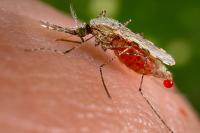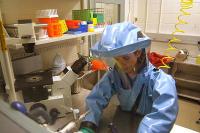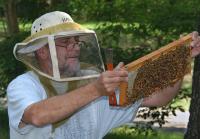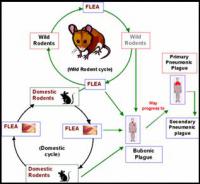-
Scientists create malaria-blocking mosquitoes

Using a groundbreaking gene editing technique, scientists have created a strain of mosquitoes capable of rapidly introducing malaria-blocking genes into a mosquito population through its progeny, ultimately eliminating the insects’ ability to transmit the disease to humans. The technique holds the promise of eradicating a disease that sickens millions annually.
-
-
Study finds that Ebola vaccine is safe, stimulating strong immune responses

A clinical trial of a new Ebola vaccine that resulted from an unprecedented global consortium assembled at the behest of the World Health Organization (WHO) has found that it is well tolerated and stimulates strong immune responses in adults in Mali, West Africa and in the United States. If the vaccine is ultimately found to be safe and effective, it could offer crucial protection for contacts (family members, neighbors, etc.) of patients with confirmed Ebola disease in future epidemics, thereby helping to interrupt transmission. Larger trials of the vaccine sponsored, by GSK Biologicals, have already begun.
-
-
How infectious diseases become epidemics
Researchers are exploring how diseases spread across long distances in an effort to learn how better to control the next human, animal, or plant epidemic. The researchers will study data for vector-borne infectious diseases to model how these types of epidemics spread. Vector-borne diseases are spread by infectious microbes transmitted by ticks, mosquitos, or other insects or parasites.
-
-
Surface Enhanced Raman Scattering (SERS) technology for on-site detection
Surface Enhanced Raman Scattering (SERS) technology currently is applied using chemical analysis of materials, such as scanning at airports to identify what materials may be inside of glass vials. Researchers want to expand SERS for use in biological applications that could employ antibodies for purposes such as identifying viruses, water toxins, or pathogens in food samples. The researchers work on developing a small hand-held device that allows users to take a sample, put it in a glass vial and insert into the instrument for rapid identification.
-
-
Novel statistical model maps lethal route of Ebola outbreak
The traditional method to track disease spread is contract tracing, in which health workers interview patients and everyone they came into contact with. Contact tracing, however, is highly labor intensive. Using a novel statistical model, a research team mapped the spread of the 2014-15 Ebola outbreak in Sierra Leone, providing the most detailed picture to date on how and where the disease spread and identifying two critical opportunities to control the epidemic. The result matches with details known about the early phase of the Ebola outbreak, suggesting the real-time value of the new method to health authorities as they plan interventions to contain future outbreaks, and not just of Ebola.
-
-
Nanoparticle delivery maximizes drug defense against bioterrorism agent
Scientists have developed a nanoparticle delivery system for the antibiotic moxifloxacin that vastly improves the drug’s effectiveness against pneumonic tularemia, a type of pneumonia caused by inhalation of the bacterium Francisella tularensis. The scientists show how the nanoparticle system targets the precise cells infected by the bacteria and maximizes the amount of drug delivered to those cells.
-
-
DoD awards $7.6 million to Pitt to develop therapies against biowarfare
The U.S. Department of Defense (DOD) has awarded a $7.6 million grant to a collaborative group of scientists in the University of Pittsburgh Center for Vaccine Research (CVR) for work which could lead to countermeasures against bioterrorism attacks. The contract is the latest in a successful run of federal funding for this group of investigators within Pitt’s CVR, which the DOD acknowledges has performed well.
-
-
Killer bees send six to hospital in Arizona

The Maricopa, Arizona fire department said six people were hospitalized on Saturday afternoon after a swarm of bees attacked residents in the Rancho El Dorado subdivision. The bees swooped down on residents of a two-block area in the subdivision about 5 p.m. Both kids and adults ran screaming for cover. Experts say the bees are a strain of the Africanized honeybee, also known as the killer bee, which is a crossbreed between the European honeybee and the African honeybee.
-
-
Oregon teen infected with bubonic plague

Health authorities in Crook County, Oregon, confirmed that a teenage girl has contracted bubonic plague from a flea while on a hunting trip. The girl became sick five days after the trip started on 16 October; and was rushed to a hospital in Bend, Oregon on 24 October.
-
-
Centralized leadership, major reform needed to bolster U.S. biodefense
A comprehensive report on U.S. biodefense efforts calls for major reforms to strengthen America’s ability to confront intentionally introduced, accidentally released, and naturally occurring biological threats. The report details U.S. vulnerability to bioterrorism and deadly outbreaks and emphasizes the need to transform the way the U.S. government is organized to confront these threats. Recommendations include centralizing leadership in the Office of the Vice President; establishing a White House Biodefense Coordination Council; strengthening state, local, territorial, and tribal capabilities; and promoting innovation through sustained biodefense prioritization and funding.
-
-
Syria’s civil war, Europe’s refugee crisis the result of spikes in food prices: Experts

The disintegration of Syria and Europe’s refugee crisis are only the latest tragic consequences of two spikes in food prices in 2007-08 and 2010-11 that triggered waves of global unrest, including the Arab Spring. Researchers have traced these spikes and spiraling crises to their root causes: deregulated commodity markets, financial speculation, and a misguided U.S. corn-to-ethanol fuel policy which removes nearly five billion bushels of corn from markets each year.
-
-
$100 million NIAID contract to SRI International to develop radiation exposure treatment

SRI International has been awarded a resource contract of up to $100 million over five years by the National Institute of Allergy and Infectious Diseases (NIAID), part of the National Institutes of Health, for the development of products to mitigate or treat acute or delayed effects of radiation exposure.
-
-
Study: Persian Gulf could experience deadly heat
Detailed climate simulation shows that the Persian Gulf region would likely cross the threshold of survivability unless mitigation measures are taken. That tipping point involves a measurement called the “wet-bulb temperature” which combines temperature and humidity, reflecting conditions the human body could maintain without artificial cooling. That threshold for survival for more than six unprotected hours is 35 degrees Celsius, or about 95 degrees Fahrenheit, according to recently published research (the equivalent number in the National Weather Service’s more commonly used “heat index” would be about 165 F). The researchers say that hot summer conditions that now occur once every twenty days or so “will characterize the usual summer day in the future.”
-
-
Birth tourism in the U.S. delivers complex medical cases in neonatal units
Researchers examined reported “birth tourism” in the United States and how it affects neonatal intensive care unit hospitalization. They found that expectant mothers traveling to the United States with the expressed purpose of giving birth before returning home are presenting more complex medical, social, and financial challenges at a large metropolitan children’s hospital. The researchers documented a higher medical complexity, longer hospital stays, and increased re-hospitalization among babies born to traveling families.
-
-
Medical research techniques to help food crops withstand climate change

Roughly one in nine people on Earth do not have enough food to eat. And climate change is only making it harder for farmers to meet the global demand for food, according to the Intergovernmental Panel on Climate Change (IPCC). By 2030, the IPCC expects climate change to reduce crop and pasture yields by as much as 14 percent in some parts of the world. Adapting crops, livestock, and fisheries will be critical for global food security. A new Center for Research on Plant Transporters (CROPS) at UC San Diego aims to help develop the molecular tools necessary to grow the hardier crop varieties that farmers need now and will increasingly need in coming years — corn, wheat, and rice that are more tolerant to heat, drought, salinity, and other adverse conditions.
-
More headlines
The long view
We Ran the C.D.C.: Kennedy Is Endangering Every American’s Health
Nine former leaders of the Centers for Disease Control and Prevention (CDC), who served as directors or acting directors under Republican and Democratic administrations, serving under presidents from Jimmy Carter to Donald Trrump, argue that HHS Secretary Roert F. Kennedy Jr. poses a clear and present danger to the health of Americans. He has placed anti-vaxxers and conspiracy theorists at top HHS positions, and he appears to be guided by a hostility to science and a belief in bizarre, unscientific approaches to public health.
